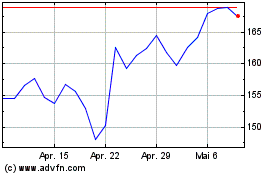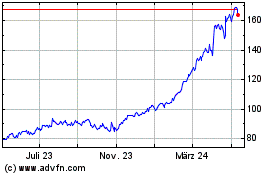By John D. Stoll
BLACKSBURG, Va. -- It's been a choppy ride for many of the folks
relying on paychecks from Boeing Co. Slammed by the pandemic and
the grounding of its most important plane, the aerospace giant said
recently that it expects to end 2021 with 30,000 fewer workers than
it started this year.
"Decisions like these are not easy," Boeing Chief Executive
David Calhoun said on a webcast. These job cuts come as the airline
industry weathers an unprecedented travel drought and Boeing
endures a "year that is among the most difficult in our 100-year
history."
Even as Mr. Calhoun shows current employees the exit, he is
pushing forward a program at Virginia Tech, his alma mater,
designed to better prepare the next-generation's workforce to avoid
a similar fate.
An accountant by training, the 63-year-old executive recently
told me Corporate America mislabels what he calls a "discovery gap"
as the "skills gap." Colleges, he said, do a yeoman's job churning
out competent coders, scientists and engineers. Such skills are in
long supply. Where they fall short is teaching how to think outside
the cubicle or beyond the screen in front of them.
"We're now trying to solve for things outside just the raw
technology, and we have very few people who are really skilled at
doing that kind of thing," Mr. Calhoun said. Creating autonomous
planes that don't need a physical pilot in the cockpit (think
pilotless cargo aircraft or urban air taxis) or repairing flawed
product programs require as much understanding of how humans are
designed as machines are.
"Usually we are left on our own to develop that discovery
muscle, and we don't usually get these program or project leaders
-- the one or two who look like they are really good at that kind
of thing -- usually they are in their mid 40s or early 50s," he
said.
Virginia Tech's Honors College serves as the starting point for
Mr. Calhoun's crusade to churn out more competent thinkers at a
younger age.
He started the Calhoun Discovery Program with a $20 million gift
in 2018 when he was on Boeing's board and Boeing's problems with
the 737 MAX airliner had yet to turn the company upside down. The
program resembles a hands-on mixer for people with different
interests and ambitions in life, collaborating on projects that
require a multitude of approaches and specializations to complete.
The goal: teach students that problem-solving requires both sides
of the brain.
I visited the Calhoun program in October as dozens of freshmen
and sophomores with majors ranging from environmental policy to
industrial design to journalism clustered in groups. They were
discussing progress on real-world projects handed to them by active
employees at Boeing, General Electric Co. and Caterpillar Inc., and
overseen by professors from diverse disciplines.
Most students in the program are on campus, often working from
dorms or other locales that allow them to collaborate virtually.
But Virginia Tech is open for classes, and students often
congregate in workshops or areas where they can craft solutions and
test ideas in person.
One group of freshmen, working on a GE warehousing problem, had
drawn up a schematic to illustrate potential solutions. When I
asked for details, Claudia Budzyn, an environmental policy and
planning major, flipped around her laptop to show me how her team's
"Speedy System" worked. As I looked, the team talked me through the
complex web of sensors, data and checkpoints they created to hasten
the order-to-delivery process.
One student told me if GE is going to survive, it needs to think
more like Amazon and less like GE.
Mr. Calhoun checked in with Ms. Budzyn and dozens of her cohorts
in late October, just days before the latest jobs-cuts
announcement. He wanted to reassure them this somewhat
unconventional style of education is valuable.
"Our own team of very experienced engineers and Ph.D.s are
working on those exact same projects, trying to figure out how to
foolproof our system or create opportunities in our businesses," he
said during a 30-minute Zoom call that I listened in on. He
concluded by saying his time spent with students is among his
favorite memories in recent months.
"You're working on real things -- these are not little
projects," he said. He's given similar talks to sophomores who are
in the second year of this program, which was established in
2019.
Sydney Szabos, an 18-year-old engineering major focused on
electrical applications, told me the message took root.
She devotes countless hours to solving riddles the program
throws at her, in addition to her other classes outside of it. Few
of those riddles are solved without the help of
non-engineering-minded colleagues.
Under the guidance of experts from Caterpillar, Ms. Szabos and a
team of classmates currently are trying to figure out how to
program drones to inspect autonomous mining equipment stationed in
remote locations.
Ms. Szabos explained to me why computer-aided design renderings
are more efficient than global positioning systems and less
expensive than lidar technologies to guide drones. (Lidar is the
gadgetry seen on the roofs of autonomous test cars, using laser
light and other technology to judge distances.) One of her
classmates told me they think it may be possible to dock and
recharge these drones on the mining equipment.
All of this is trial-and-error at this point. Student teams
check in often on Zoom calls with working professionals to refine
their plan or change course.
I asked Ms. Szabos how this differs from core engineering
courses. "We're making paper airplanes in one of them," she said. I
thought it was a joke until she walked me through how making a
perfect paper airplane is an essential building block for the
discipline.
"It's just a different way of learning," she said. "There, we're
starting smaller and working our way up. Here, we start big and
stay big."
Why?
Charles "Chip" Blankenship, an adjunct professor at Virginia
Tech who worked with Mr. Calhoun at GE's aviation business years
ago, said companies have long encouraged single-minded focus on
business problems.
When he was running GE's appliance business he said the focus
could be so heavily skewed toward hitting financial targets, or
winning regulatory approval on a near-term project, or perfecting
the technology on the next product launch, that staffers failed to
consider the bigger picture. That unit was eventually sold off.
"You need that short-term focus, of course," he said. "But a big
part of your organization needs to spend their time looking around
corners." Those who haven't "flexed the discovery muscle" (one of
Mr. Calhoun's favorite sayings) by leveraging multiple fields of
study while trying to problem solve don't know what corners to look
around.
As Boeing, for instance, tries to tackle autonomous airplanes,
Mr. Calhoun said solving the technology isn't the problem. "Our
problem is going to be how do you get a regulator to allow for or
provide for air traffic over a given city. You're going to have to
understand the political-science consequences" to make that
happen.
For D'Arrin Calloway, that kind of cross-pollination was what he
was looking for coming out of Lynchburg, Va.'s Heritage High School
in 2019, but didn't know how to pursue. He applied to 40 schools
and was accepted to many. Virginia Tech wasn't high on the list
until he visited an open house and found out about this program and
heard Mr. Calhoun's pitch.
"I was pretty sold from then on," Mr. Calloway said. One of the
important keywords he heard was "collaboration" and the promise of
meeting students from various backgrounds and interests -- an
experience he felt was lacking in his hometown.
Mr. Calloway's interests are broad. He applied to several
engineering schools, but then considered a double major in real
estate and finance at Virginia Tech. The Calhoun program introduced
him to the field of business information technology, which appealed
to his entrepreneurial spirit.
Now a sophomore, the 19-year-old Mr. Calloway has worked on
college-diversity projects, built a website, learned the art of
video editing and conducted analysis on regional incentives for
energy infrastructure.
"My major has nothing to do with a lot of these things, and I
was never expecting to do classes like these," he said. "It changes
the way I approach every project."
Write to John D. Stoll at john.stoll@wsj.com
(END) Dow Jones Newswires
November 13, 2020 11:18 ET (16:18 GMT)
Copyright (c) 2020 Dow Jones & Company, Inc.
GE Aerospace (NYSE:GE)
Historical Stock Chart
Von Apr 2024 bis Mai 2024

GE Aerospace (NYSE:GE)
Historical Stock Chart
Von Mai 2023 bis Mai 2024
